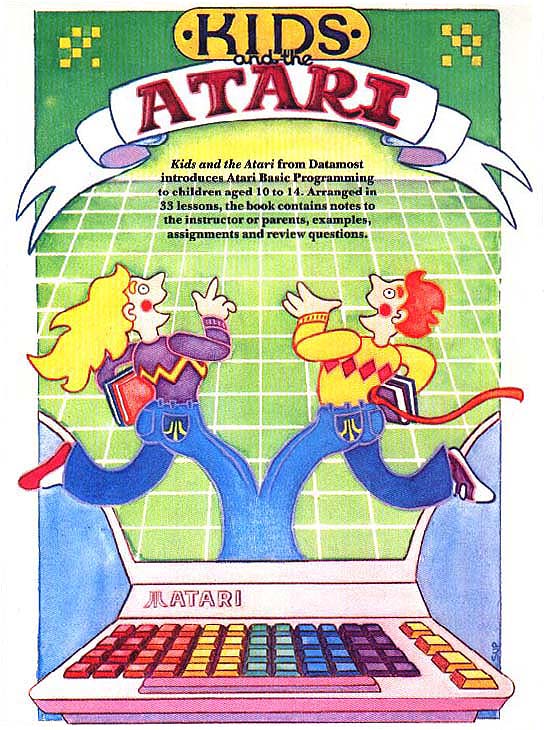
|
Beginning with elementary vocabulary, the book moves quickly to writing simple programs, then emphasizes more advanced and powerful commands.
Hi-Res Magazine believes the study of programming enhances a child's learning experiences and wants to acquaint its readers with a valuable learning tool. We'll be presenting a lesson from Kids and the Atari each month over the next few issues.
Kids and the Atari was written by Ed Carlson who holds a Ph.D. in physics from John Hopkins. He is a member of the Department of Physics and Astronomy at Michigan State University.
Kids and the Atari is published by Datamost, Inc. 8943 Fullbright Ave., Chatsworth, CA 91311.
-Eds.
INTRODUCTION
INSTRUCTOR NOTES 1
PRINT, NEW, REM, AND RUN
This lesson is an introduction to the computer.
The contents of the lesson:
1. Turning on the computer.
2. Typing verses entering commands or lines.
RETURN key.
3. The computer only understands a limited number of commands.
4. In this lesson, NEW, PRINT, REM, RUN.
5. What a program is. Numbered lines.
6. Clearing the screen.
7. Memory can be cleared with NEW.
8. What is seen on the screen and what is in memory are different. This may be a hard concept for the student to grasp at first.
9. RUN makes the computer go to memory, look at the commands in the lines (in order) and perform the commands.
10. One can skip numbers in choosing line numbers, and why one may want to do so.
QUESTIONS
1. Write a program that will print your name.
2. Run it.
3. Make the program disappear from the TV screen but stay in memory.
4. Run it again.
5. Erase the program from memory.
LESSON 1
PRINT, NEW, REM, AND RUN
Getting Started
Put the BASIC COMPUTING LANGUAGE cartridge in the ATARI computer. The label side is toward you. If you have an ATARI 800, put the cartridge in the left slot.
Turn on the computer. You will see:
READY
Below READY is a square. This square is called the "cursor." When you see it on the screen, the computer wants you to type something.
"Cursor" means "runner." The square runs along the screen showing where the next letter you type will appear.
TYPING
Type some things. What you type shows on the TV screen.
ERASING THE SCREEN
Two keys together erase the TV screen.
Hold down one of the SHIFT keys and press the CLEAR key. The screen is erased.
CLEAR stands for "clear the screen." "Clear" means the same as "erase."
COMMAND THE COMPUTER
Try this. Type:
GIVE ME CANDY
and press the RETURN key.
The computer says:
ERROR-GIVE ME CANDY
The computer only understands about 80 words. You need to learn which words the computer understands. Here are the first four words to learn:
NEW, PRINT, REM and RUN.
THE NEW COMMAND
Type:
NEW
and press return RETURN.
NEW empties the computer's memory so you can put your program in it. It doesn't erase anything from the TV screen.
HOW TO ENTER A LINE
When we say "enter" we will always mean to do these two things.
1. type a line
2. then press the RETURN key.
Enter this line:
10 PRINT "HI"
(The " marks are quotation marks. To make quotation marks, hold down the SHIFT key and press the key that has the 2 and the " on it.)
(Did you remember to press the RETURN key at the end of the line?)
Now line number 10 is in the computer's memory. It will stay in memory until you enter the NEW command, or until you turn off the computer. Line 10 is a very short program.
THE NUMBER ZERO AND THE LETTER "0"
The computer always writes the zero like this:
zero 0
and the letter O like this:
letter O O
You have to be careful to do the same.
right 10 PRINT "HI"
wrong 1O PRINT "HI"
WHAT IS A PROGRAM?
A program is a list of commands you wish the computer to do. The commands are written in lines. Each line starts with a number. The program you entered above has only one line.
HOW TO RUN A PROGRAM
A moment ago you put this program in memory:
10 PRINT "HI"
Now enter:
RUN
(Did you remember to press the RETURN key?)
The RUN command tells the computer to look in its memory for a program and then to obey the commands it reads in the lines.
Did the computer obey the PRINT command? The PRINT command tells the computer to print whatever is between the quotation marks. The computer printed:
HI
A LONGER PROGRAM
Clear the memory with:
NEW
(Did you remember to press RETURN afterward?)
Enter this, program:
1 REM PROGRAM
2 PRINT "HI"
3 PRINT "FRIEND"
This program has three lines. Each line starts with a command.
Enter:
RUN
Line 1-the computer skips this line because it is a REM.
Line 2-the computer prints "HI."
Line 3-then computer prints "FRIEND." The REM command lets you put little notes to yourself in the program. REM means "remark" or "reminder."
In line 1 we used REM to give a name to the program. The name is "PROGRAM L" The computer does the commands in the lines. It starts with the lowest line number and goes down the list in order.
HOW TO NUMBER THE LINES IN A PROGRAM
Usually you will skip numbers when writing the program.
Like this:
10 REM PROGRAM 1
20 PRINT "HI"
30 PRINT "FRIEND"
It is the same program but has different numbers. The numbers are in order, but some numbers are skipped. You skip numbers so that you can put new lines in between the old lines later if the program needs fixing.
Assignment 1:
1. Show how to "clear the screen."
2. Use the command NEW. Explain what it does.
3. Write a program that uses REM once and PRINT twice. Then use the RUN command to make the program obey the commands.